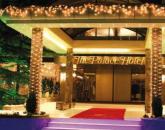Exhibition "Garden of Eden in Russian Art of the 17th - early 20th century" - report. Exhibition of Russian tiles of the 16th-19th centuries
The Moscow State United Museum-Reserve has a unique collection of building ceramics, which is rightfully considered one of the best in Russia. Tiles make up the largest and most significant part of the collection.
The exhibition will show the history of Moscow tiles from the moment of their inception to the present day, its changes and features from the 15th to the 20th centuries, both in stove and facade ceramics, will be traced.
Visitors to the exhibition will learn about the "golden" age of Moscow tiles - the heyday of facade ceramics in the 17th century, which can be imagined by the details of ceramic facade decoration stored in the MGOMZ funds.
The exhibition will present tiles from the collection of the Moscow State United Museum-Reserve, tiles from the collections of contemporary ceramic artists, tiles from the collection of MHPGU. them. Stroganov.
The exhibition "Moscow tile" has its own background. In the 1930s Moscow tiles were widely represented at the exhibition "Technique and Art of Construction in the Moscow State of the 16th-17th Centuries" created by P. D. Baranovsky in the Kolomenskoye Museum. In 1980, the exhibition "Moscow Architectural Ceramics" was opened in the museum in Sytny Dvor. The last exposition, created in 1996, "Moscow tile" until 2007, remained the only exposition in Moscow, representing in its entirety the history of Moscow tile production.
Thus, addressing this topic is traditional for the museum.
The unique collection of building ceramics, which the Moscow State United Museum-Reserve possesses, is rightfully considered one of the best in Russia. It has about 14,000 items and represents the whole variety of building ceramic products: bricks, tiles, pipes, golosnikov, floor and wall tiles, but the most significant part of it is made up of tiles.
Holding an exhibition in Izmailovo is not accidental. It is here that the Pokrovsky Cathedral and the Mostovaya Tower are located - outstanding monuments of the 17th century with tiled decoration. The works of contemporary ceramists, experts in the field of restoration of facade ceramics, presented at the exhibition, also allow us to touch upon the topic of preserving the tiled decor of Moscow that has survived to this day. The exhibition will run until next spring.
Send to a friendVisitors to the exhibition of tiles of the 15th-19th centuries, which will open on April 27 at the Sergiev Posad Museum-Reserve in the Moscow region, will be able to see more than 350 unique exhibits, among which are both elements of ancient church decor and works by famous artists of the century before last, the press said. services of the Trinity-Sergius Lavra.
“The Sergiev Posad State Historical and Art Museum-Reserve will open on April 27, 2018 exhibition of tiles of the 15th-19th centuries "From sample to tile". In the East building Museum complex "Horse Yard" more than 350 unique exhibits will be presented to the audience,” the message says.
The exhibits were provided by the Moscow United Art Historical-Architectural and Natural-Landscape State historical museum, State Historical, Artistic and Literary Museum-Reserve "Abramtsevo" , State Research Museum of Architecture named after A.V. Shchusev and the museum and exhibition complex of the Moscow region “New Jerusalem.
The exhibition will acquaint visitors with the development of tiling in Russia from the 15th to the 21st century. At the exhibition you will see many creations created in Trinity Sergius Monastery and decorating temples cloisters, in particular, one of the earliest finds: a rare fragment of terracotta relief tiles and a decorative baluster Spiritual Church of the 15th century, as well as exhibits of the decor of the Vvedenskaya Church of the 16th century. No less interesting are the etched (green) tiles of the 17th century from the decor of the Church of the Monks Zosima and Savvaty of Solovetsky.
The audience will also see the reconstruction of two old ovens from Sergiev Posad and tiles made by famous masters Jan Flegner in the 18th century and Mikhail Vrubel in the 19th century. In addition to tiles, the exhibition will feature graphic works by such famous masters as Vrubel, E. Polenova, V. Hartman, S. Miloradovich.
“The exhibition will be of interest not only to a narrow circle of art historians, but also to the general public, as it will allow the mass audience to get in touch with the “witnesses of living history” - old tiles,” the message says.
More related posts
Context Help
— Spiritual Church (1476)
Located to the east of the Trinity Cathedral, the Church of the Descent of the Holy Spirit (Spiritual Church), closes the southeastern corner of the cathedral square, organically included in the architectural...
— Historical and architectural complex "Horse Yard"
"Horse Yard" is an exposition and exhibition and cultural and leisure complex of the Sergiev Posad State Historical and Art Museum-Reserve, which includes ...
— All exhibitions in Sergiev Posad region
Information about exhibitions in the city and the region, both passing and preparing for the opening. Posters of museums, galleries and exhibition halls.
— Profession oven maker
I have always been fascinated by people who can create something with their own hands. On the pages of our project, we often publish reviews about companies in the Sergiev Posad region, but about people - masters...
— Temples and churches
In addition to the Trinity-Sergius Lavra in Sergiev Posad and the region there are a huge number of temples, chapels and churches. Here you can see photographs, learn the history, features of architecture, interesting historical facts about the temples and churches of the city and the Sergiev Posad region.
— Trinity Sergius Lavra
Over the centuries, on the territory of the Holy Trinity Sergius Lavra, a unique ensemble of multi-temporal buildings has developed, including more than fifty buildings and structures.
In the southwestern part of the monastery is the white-stone Trinity Cathedral (1422-1423), built on the site of the first wooden church of the XIV century. It was around him that the formation of the monastery ensemble took place. To the east of the cathedral in 1476, Pskov craftsmen erected a brick belfry church in the name of the Descent of the Holy Spirit upon the Apostles.
— Sergiev Posad and its region - a region with richest history. The history of Sergiev Posad has almost seven centuries of eventful life. The Trinity-Sergius Monastery was founded in 1337 by St. Sergius of Radonezh. In the XIV - early XV centuries. several settlements arose around the monastery (Kukuevo, Panino, Klementyevo, etc.), united in 1782 by decree of Catherine II into a city called Sergievsky Posad. From 1930 to 1991, Sergiev Posad was called Zagorsk, in memory of the deceased secretary of the Moscow Committee of the .M. Zagorsky, then the historical name was returned to the city.
— Abramtsevo Museum-Reserve
For the first time Abramtsevo (then Obramovo) was mentioned in 1504 in the charter of Ivan III. The village got its name because of the terrain: frame (from the word frame).
Bridge tower. Built by decree of Tsar Alexei Mikhailovich. In the 17th century in the lower tier there were archery guards, in the upper tier - a chamber, a clock and a bell tower.
Under Tsar Alexei Mikhailovich in 1667, the Robka River (now Serebryanka) was blocked by dams, forming the Silver-Grape Pond, which surrounded Izmailovsky Island with the royal estate. The Sovereign's Court served as the center of the estate (it was built in 1664-1690). Around it there was a poultry house, a garden where outlandish plants were grown, and many other outbuildings.
The core of the exposition is the royal gates, which were made in the royal workshops, where the ancient traditions of Russian woodworking and Western tradition intertwined.
Royal doors. Workshop of the Armory.
They come from the church of Cosmas and Damian in the Lower Sadovniki.
Russia Moscow. Second half of the 17th century. Wood, gesso; carving, tempera, gilding.
This carving is called Flemish. The name has two versions of origin: the first - from the German flämisch - Flemish, and the second from the German flamme - flame. This virtuoso baroque carving was dominated by plant motifs, in this case the vine motif, which has a huge amount of biblical symbols. Here, the symbolism of paradise, the Eucharist, the Church, the Mother of God intertwined. Recording the symbols of Western traditions turned out to be close to the Russian customer, primarily to the tsar and his entourage.
Detail of the Royal Doors. Restoration insert.
On the gates, restoration inserts are visible, made of linden, using the same technology and covered with gesso. These inserts do not have red polyment (primer for gilding) and gilding itself.
Detail of the Royal Doors. A red polymer is visible.
Russian art of the 17th century is one of the most striking embodiments of the image of the Garden of Eden. This is connected, on the one hand, with the restoration and strengthening of the Russian state after the Time of Troubles, on the other hand, with the expectation of the end of the world in connection with the year 1666 from the Nativity of Christ. Interest in "paradise themes" manifested itself not only in reading and writing texts related "to the end of time", but also in the creation of earthly "Icons" of Paradise.
General view of the hall.
Pay attention to the white stone pillars and carvings on them. How it echoes the Flemish woodcarving of the Royal Doors.
Carved column. Base. Comes from the Simonov Monastery. Russia Moscow. 1677 - 1683s. White stone; tesk, carving.
We say “white stone”, but white is its natural color, which was used only in the Naryshkin style. And these pillars were tinted, the background was red or azure, and the protruding parts were golden.
Carved column. Comes from the Church of St. Nicholas the Wonderworker "Big Cross".
Russia Moscow. 1680 - 1689s. White stone; tesk, carving.
Unfortunately, there are no columns with preserved gilding at the exhibition, but if you look closely, you can see traces of paint coating.
Glazed tiles became one of the sparkling facets of Russian art. For the first time, the production of valuable tiles was started by order of Patriarch Nikon in the Valdai Iversky Monastery, later a workshop was created in the New Jerusalem Resurrection Monastery. After the condemnation of the patriarch, many masters were taken to the Armory. Tsenina - ceramic product covered with enamel.
Relief tile panel "Bird with fruits".
From the decor of the bell tower of the Church of Saints Cosmas and Damian in Nizhnye Sadovniki. Russia Moscow. 1689 Red clay, colored enamels, brown glaze; molding, painting, firing.
Until the middle of the 17th century, only muraved (green) or terracotta (red) stove tiles were known in Russia. But after the inclusion of the western Belarusian lands into the state, the masters who know the secrets of colored irrigation (paints) are invited by the patriarch to decorate the temples. Along with the masters come not only technologies, but also symbols and images of Western art: cornucopia, laurel and acanthus leaves.
Cornucopia.
The platband is tiled relief polychrome. Comes from the Church of the Holy Great Martyr Paraskeva Pyatnitsa in Okhotny Ryad. Russia Moscow. 1686 -1687. Clay is red, enamels are colored, glaze is brown; molding, painting, firing.
The clypeus uses the image of laurel leaves. It may have been reworked from a Western European engraving.
And this tile presents us with a pattern of acanthus leaves.
Polychrome embossed facing tile. Comes from the Church of the Martyrs Adrian and Natalia, in Meshchanskaya Sloboda. Russia, Moscow, 1688. Red clay, colored enamels, brown glaze; molding, painting, firing.
Talking about glazed tiles, it is impossible to get around the most famous cynic master Stepan Ivanov Polubes. His skill was so great that he was one of the few who could create large tiled layers. The larger the formation, the more opportunities for its deformation and damage. The whole process was controlled by eye according to the color of the flame, each tile was fired 5-6 times and had a considerable cost.
Relief polychrome panel "John the Evangelist". Master - Stepan Ivanov (Polubes).
Comes from the Church of the Holy Fathers of the Seven Ecumenical Councils of St. Danilov Monastery. Russia Moscow. End of the 17th century. Clay is red, enamels are colored, glaze is brown; molding, painting, firing.
It was not by chance that John the Theologian appeared at this exhibition, it is he who introduces us to the future paradise, the heavenly Jerusalem and complements the image of the paradise-garden with a city built of gold and precious stones.
A technological defect is visible on this layer, but because of their high cost, tiles with such a defect were not considered defective. To give you an idea of the cost, let's take an example. For three thousand tiles that went to decorate the Intercession Cathedral in Izmailovo, the craftsmen were paid 250 rubles. Three rubles cost a small village (3-4 yards),
Relief polychrome tile "Cherub". Master - Stepan Ivanov (Polubes).
Comes from the Church of the Hieromartyr Yermolai on Bolshaya Sadovaya. Russia Moscow. 1682 Red clay, colored enamels, brown glaze; molding, painting, firing.
Many such tiles were produced for the New Jerusalem Monastery, it is possible that he came from there together with the masters after the disgrace of Patriarch Nikon. And at the exhibition you will be able to examine this tile in more detail and see what other dangers lay in wait for such large products.
Relief polychrome tiles. From the decor of the bell tower of the Church of St. Nicholas the Manifested, on the Arbat. Russia Moscow. Early 1680s. Clay is red, enamels are colored, glaze is brown; molding, painting, firing.
These tiles are especially dear to museum workers, as similar ones adorn the Bridge Tower, where the exhibition is being held.
Tiled decorations of the Bridge Tower.
Going around the tower, you can see that with the help of one form and different colors, the masters achieved a huge variety of tiles. Also, the tiles often depicted the bird of paradise “papagai”, which was brought as a gift by Western European ambassadors. It was believed that the effect of water is harmful to this bird, since it lives in paradise, where it does not rain. Therefore, they were afraid that water could wash away the beautiful color of plumage.
After Peter's reforms, the dream of Tsar Alexei Mikhailovich's paradise did not disappear anywhere. She went into the folk tradition, where Christian ideas were intertwined with folk deep beliefs. And the birds of paradise intertwined with ancient protective ornaments, mermaids and other fairy-tale characters.
A lion. The board is cornice. Alexey Borisovich Voronin (?). Russia, Nizhny Novgorod province. Second half of the 19th century. Tree; thread.
Mermaid. Frontal eaves board. Akimova's House Master. Russia, Nizhny Novgorod province, Balakhna district, 1860s. Tree; thread.
The Bridge Tower, which served as the entrance to the earthly paradise of Tsar Alexei Mikhailovich, and now guards the ideas of the paradise of our ancestors, and ourselves, has turned into such a storehouse of treasures. Let us also remember, sinners, the Heavenly Jerusalem.
We express our deep gratitude to the press service of the Moscow State United Art Historical-Architectural and Natural-Landscape Museum-Reserve for the opportunity to visit the exhibition and to Valery Viktorovich Zuykov, Head of the Methodological Department of the United Museum-Reserve, for an excellent tour of the exposition.
Also, you can use the new suluga of the museum "photo shoot in historical costumes".
For the convenience of participants in a costumed photo session, a dressing room has been determined in the Bridge Tower. The duration of 1 session of photography is set - 20 minutes, taking into account the time for changing clothes.
Service price: 1 person - 200 rubles, 2 people - 300 rubles, 3 people - 500 rubles, 4 people and more (if suits are available)- 600 rubles
Address: town them. Bauman, d.2, p. 14. Directions: from the station. m. "Partisan", troll. 22 to stop. "Main Alley". Map.
Working hours: Tuesday - Friday, Sunday from 10.00 to 18.00, Saturday from 11.00-19.00 (in summer), 10.00-18.00 (in winter)
Monday is a day off.
Ticket price:adult - 50 rubles, preferential - 30 rubles.
Each third Sunday months - the entrance is free.
On July 3, the Andrei Rublev Museum opened an exhibition dedicated to Russian tiles of the 16th-19th centuries.
The exhibition presents a part of the museum's collection of tiles, which, although not large in volume, but gives a holistic view of the history of the art of "valuable work" in Russia. These are facade and stove tiles, embossed and smooth, covered with glaze and painted. The chronological coverage of the presented works is from the 16th to the end of the 18th century. Since such expositions are extremely rare, the opening of the exhibition was an event.
The exhibition was opened by the director of the Andrey Rublev Museum M.B. Mindlin.
Anastasia Gorshkova, curator of the archeology fund and collection of tiles, presented the exhibition catalog.
The curator of the tile fund of the Moscow State United Art Historical, Architectural and Natural Landscape Museum-Reserve, a leading specialist in Russian tiles, S.I. Baranova, addressed the audience with a welcoming speech, who noted the importance of opening the exhibition and publishing the catalog.
The geography of the products presented in the collection is just as extensive, including tiles from Moscow, Yaroslavl, Ustyug, Vologda, Kaluga, Vladimir and other famous centers, as well as samples of European and Oriental ceramics.
The collection includes the oldest ceramic glazed tiles that were used to decorate buildings. Kievan Rus in the X-XI centuries; embossed terracotta slabs, which at the end of the 15th century came to Moscow Rus' to replace the traditional white stone carving; the first, so-called "red", stove tiles - ceramic tiles with a rump box on the back for fastening, decorating stoves since the end of the 16th century.
Terracotta slab from the decor of the Church of the Deposition of the Robe of the Moscow Kremlin
1485–1486

Stove tile
Late 16th - early 17th centuries
Exhibition "Milestones in the history of Kolomenskoye"
at the Front Gate of the Sovereign's Court in Kolomenskoye
The basis of the museum collection was embossed and polychrome tiles of the 17th century. They entered the museum at the end of the period of 1920-1930, when monuments of church and secular architecture were destroyed everywhere. Thanks to the enthusiasm of P.D. Baranovsky and his associates managed to preserve fragments of the tiled decor of numerous Moscow churches and bell towers in the funds of the Kolomenskoye Museum: Nicholas the Wonderworker in the Pillars (1669), Nicholas the Wonderworker Appeared on the Arbat (early 1680s), Adrian and Natalia in Meshchanskaya Sloboda (1688), Kozma and Demyan in Sadovniki (1689), Trinity in Zubov (1680s) and others. A special place among the examples of facade ceramics is occupied by ceramic panels depicting the Evangelists, made by Moscow craftsmen at the end of the 17th century.
Second half of the 17th century - truly the "golden age" of Russian tile art, the time of the appearance and wide distribution of multi-colored tiles in the decoration of stoves and building facades.

Muravlennaya tile from the decor of the Church of the Trinity in Kostroma
Moscow production,
Around 1650
Exhibition "Milestones in the history of Kolomenskoye"
at the Front Gate of the Sovereign's Court in Kolomenskoye

Ceramic panel "Bird with fruits", from the decor of the bell tower of the Church of Kozma and Demyan in Sadovniki in Moscow
1689
Exhibition "Masters. Technique and art of the Russian builder of the XV-XIX centuries"
in the Atrium of the Depository in Kolomenskoye
Ceramic panel "Evangelist Luke" from the decor of the Cathedral of the Holy Fathers of the Seven Ecumenical Councils of the Danilov Monastery in Moscow
Exhibition "Masters. Technique and Art of a Russian Builder of the 15th-19th Centuries" in the Atrium of the Repository in Kolomenskoye

Tiled stove from the Mikhailovskaya Church of the German Quarter in Moscow
1680s
The exposition "Milestones in the history of Kolomenskoye" at the Front Gate of the Sovereign's Court in Kolomenskoye
The stove tiles of the 18th century presented in the collection, made in the technique of painting on enamel, which replaced the ancient Russian products, reflect a new “living acceptance of the world”, a change in a person’s idea of his place in life.

Stove tile smooth painted
Mid 18th century
Russia Moscow
The outstanding work of the artist Mikhail Vrubel - the tiled fireplace "Mikula Selyaninovich and Volga", made in 1898, is evidence of the return of Russian artists to the "art of clay" at the end of the 19th century and the embodiment of ancient Russian traditions in a new artistic language.

Fireplace "Mikula Selyaninovich and Volga"
M. Vrubel
1898
Pottery of the Soviet period, primarily experimental tiles with portraits of V.I. Lenin, I.V. Stalin, with images of workers and Red Army soldiers complete the thousand-year history of Russian tiles, presented in the museum's collection.

Ceramic tiles
D. Tsipirovich
1928.
Moscow, Institute of Silicates
At present, the fund of tiles continues to be replenished mainly due to archaeological finds on the territory of Moscow, as well as individual tiles or complete stove sets from old Moscow houses.
Popular
- Celebration of the day of agriculture and processing industry
- When is Agriculture Day celebrated?
- Card games at the table
- Funny and funny contests for a fun company of adults
- Polish "paratroopers" for the Soviet marines
- Project 205 missile boats
- How is life on the new Chinese destroyer
- The newest frigate "Admiral of the Fleet Kasatonov" is preparing for the first tests and going to sea Ship Admiral Kasatonov
- Submarines of the Gato type
- Insignia on the merchant fleet of the USSR Detachment of the II group




